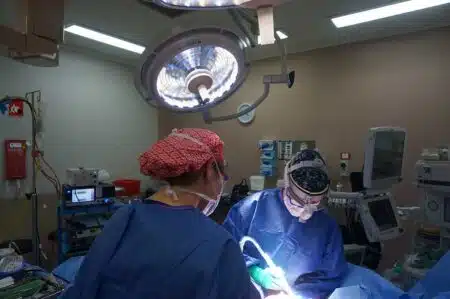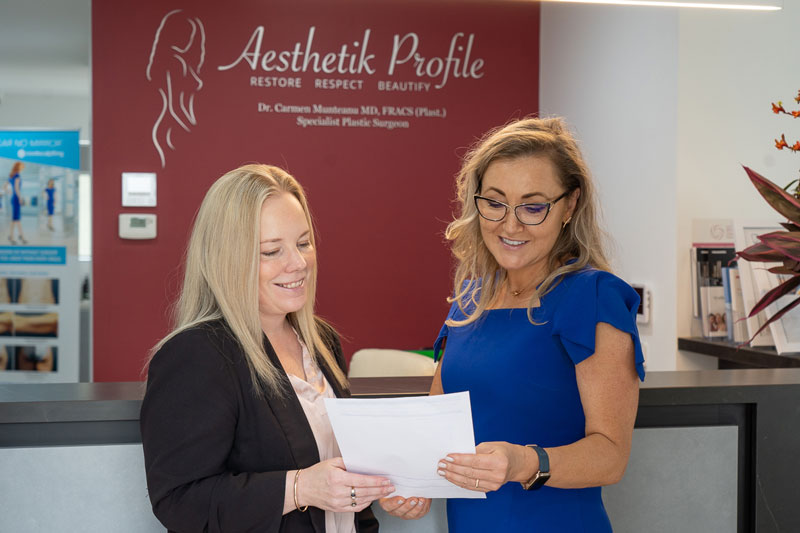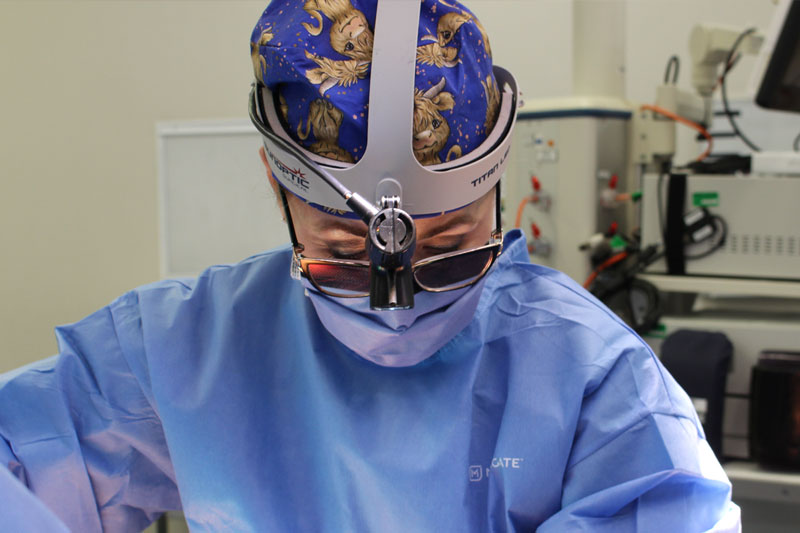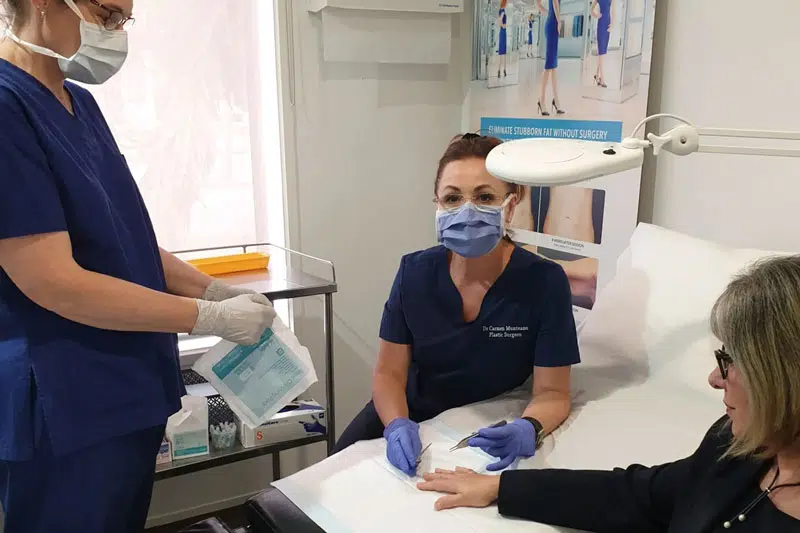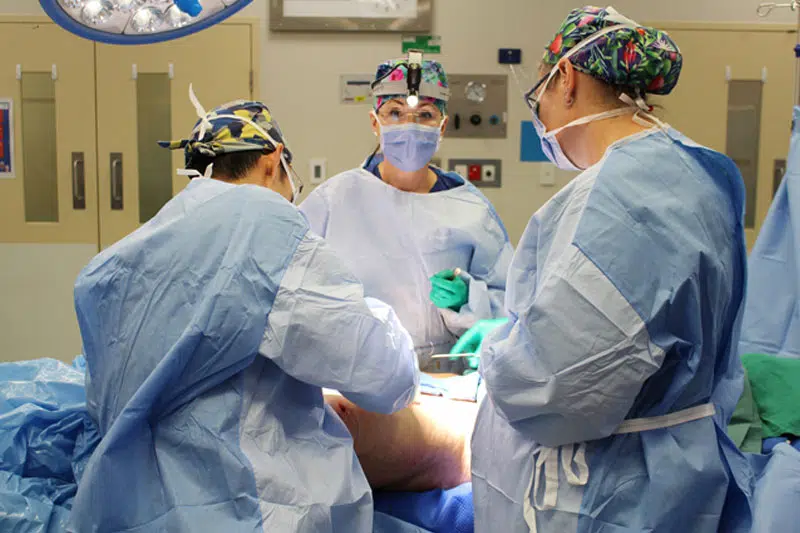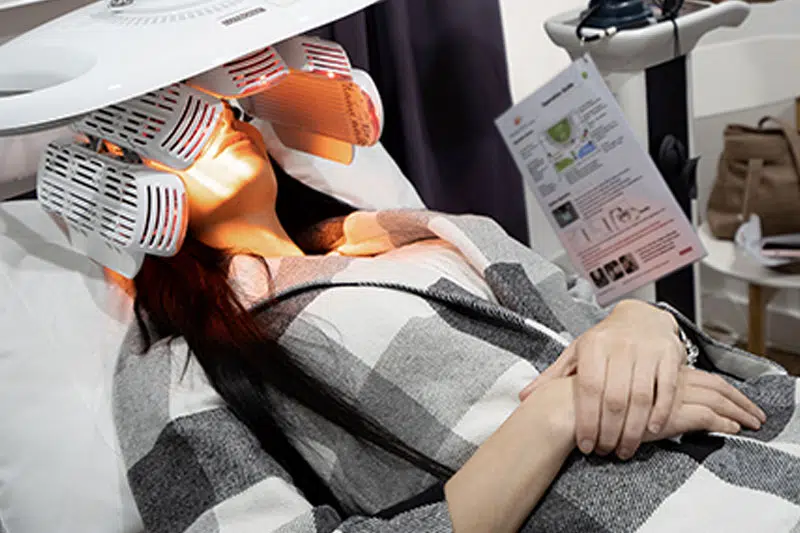BIA-ALCL and Breast Implant patients – What are the risks and implications?
What is BIA-ALCL?
A rare type of lymphoma is found associated with Breast Implants. Specialist Plastic Surgeons take their responsibility seriously and prioritise patient safety throughout the whole procedure.
Download Dr Carmen’s Guide to Breast Implant Remove and Replacement Surgery
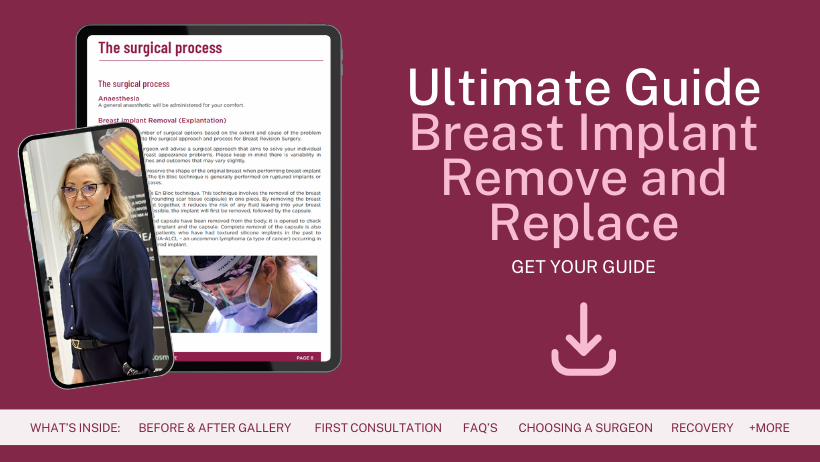
It is important to note that BIA-ALCL is NOT a common breast cancer. It is a rare type of lymphoma that develops adjacent to breast implants, usually as a swelling of the breast 3-14 years after insertion.
This swelling is due to fluid building up in the fibrous capsule that surrounds the implant and does not develop in the breast tissue itself. It can also present as a swelling or lump in the breast or armpit.
The incidence of BIA-ALCL is very low – in the millions of breast implants used worldwide, the American FDA reported 660 cases with nine deaths as of September 30, 2018. In Australia and New Zealand, 92 patients have been diagnosed with the condition, which has caused five deaths, mostly related to the treatment with radiotherapy[1]. Removing the Implant and Capsule after detection has been found to be a very effective treatment.
What Causes BIA-ALCL?
Currently, there is no exact answer to this question, but Australian and New Zealand Plastic Surgeons, along with local and international research organisations, are working hard to find the cause of BIA-ALCL. All BIA-ALCL findings are reported to the TGA in Australia and Medsafe in New Zealand.
The theory with the most scientific evidence includes bacterial growth on the surface of a textured breast implant in women with associated additional genetic risk factors. These factors may lead to the development of a sustained immune response that can turn into lymphoma in a small number of patients over a long time.
Infection Control Standards and BIA-ALCL
An international study on 42,000 Allergan Biocell and Silimed Polyurethane Breast Implants performed by Plastic Surgeons that included a ten-year follow-up on patients found no BIA-ALCL. With no cases of BIA-ALCL in 42,000 textured breast implants, this study throws up some important and helpful facts.
The link between the different surgeons was keen attention to operative detail and, in particular, bacterial mitigation strategies known as the 14-Point-Plan. The other important common feature in this study, apart from the use of the textured implant,s is the academic, scientific and technical expertise of Board Certified Specialist Plastic Surgeons who participated in this study who have all completed accredited Plastic Surgery training in their respective countries, namely USA, UK, Sweden and Australia. The technical skill of the Board Certified Specialist Plastic Surgeons and the diligent and systematic application of antimicrobial strategies routinely with breast implant surgery has translated into better outcomes as revealed in this study.
Licensed Facilities, Infection Control, use of TGA Approved Products, and a Commitment to Lifelong Learning Ensures Safety and Quality in Breast Implant Surgery.
- In Australia and New Zealand, Specialist Plastic Surgeons operate in licensed facilities that have excellent infection control standards in breast implant surgery to ensure the optimal results for patients.
- Specialist Plastic Surgeons undergo extensive training in surgical safety, infection prevention techniques, and implant selection to ensure a low risk of infection.
- To further increase patient safety in Breast Implant surgery, a 14-Point-Plan has been developed by Specialist Plastic Surgeons to minimise the risk of bacterial contamination of an implant.
- All Specialist Plastic Surgeons use only products that are approved by the TGA.
- Specialist Plastic Surgeons are committed to lifelong learning in breast implant surgery to update their skills and knowledge continually, which ensures they are equipped with the latest and advanced scientific research, skills, and technologies.
Am I At Risk of BIA-ALCL?
BIA-ALCL is a rare condition, with 92 patients confirmed in Australia and New Zealand. Due to its rarity, it’s difficult to be sure about the exact level of risk of developing this disease. The risk of developing BIA-ALCL with textured implants differs with different grades of texture from one in 2,800 to one in 80,000. Comparatively, breast cancer occurs in one in every eight women.
It occurs in both breast reconstruction cases and cosmetic cases, as well as affecting both saline and silicone implants. Contrary to some reports, worldwide, there have been no cases of BIA-ALCL in any woman who has only ever been exposed to smooth breast implants. BIA-ALCL has occurred in women with smooth implants who have previously had textured implants.
How Do I Know What Kind of Implants I Have?
The breast implant type used in your surgery will be in your original surgeon’s medical files, and they will be able to inform you if it is a textured implant.
If you are unable to contact your original surgeon, you can contact a Specialist Plastic Surgeon for a full clinical evaluation. It would be recommended that this occur in any patient with breast implants who is exhibiting symptoms of this condition.
I Have Breast Implants – What Should I do?
If you are concerned about your breast implants or worried that you may be at risk of BIA-ALCL, here’s what to do:
- Speak to a Specialist Plastic Surgeon. They can guide you through the clinical review and assess if your breast implants are amongst those in question, and recommend necessary tests and scans.
- It is advisable to contact your original surgeon. They are well-qualified to tell you which implants you have, assess your risk, and advise you appropriately.
How Can I Make Sure I Don’t Have BIA-ALCL?
- Have a full clinical examination conducted by a Specialist Plastic Surgeon to assess any your outcome and any signs of complications.
- Your Specialist Plastic Surgeon may suggest you undergo breast implant scans to comprehensively check for any implant ruptures, implant capsule formation, or fluid or seroma around the breast implant.
- If fluid or seroma is present around your breast implant, it is recommended that a sample of this fluid be sent to the laboratory for a series of specific tests. Your Specialist Plastic Surgeon will be able to coordinate this.
- For Australian patients, Medicare assistance is available after a definite diagnosis of lymphoma, and an MRI also has support once the diagnosis is confirmed.
Should I Remove My Implants or Change Them?
- At this time, there is no evidence to suggest the benefit of routine removal of breast implants if you do not have symptoms of this condition.
- However, we understand that you may choose to have your breast implants removed after considering all the information and evidence. Your plastic surgeon will understand and support your decision and guide you through the process.
- If you are having breast implant surgery or require an implant revision, your implant selection should balance your goals, your examination, and the risk/benefit assessment of your choices. Your Specialist Plastic Surgeon will be the right person to discuss the pros and cons of this option, including appropriate implant selection, and support you throughout your journey.
TGA Suspends Sale of Textured Breast Implants in Australia over concerns about BIA-ALCL – JULY 2019
The TGA announced on Thursday, 11th July 201,9, that it had completed its review and laboratory assessment of textured breast implants on the Australian market.
As the pre-eminent body representing Specialist Plastic Surgeons who specialise in cosmetic surgery, the Australasian Society of Aesthetic Plastic Surgeons (ASAPS) supports any move by the Therapeutic Goods Administration (TGA) made in the name of patient safety.
The next steps are either a proposal to cancel or a proposal to suspend certain types of textured implants by specific manufacturers. The TGA has also imposed new conditions on the inclusion of several other textured implants in the Register. You can find the full list of implants in question on the TGA’s website.
The TGA has notified each of the sponsors of the relevant proposed regulatory action (or imposition of conditions, where conditions have been imposed). The next steps are for the sponsors to respond to the TGA’s notification and invitation to comment by 24 July 2019. The TGA will, as a matter of priority, consider the sponsor’s submissions before reaching any decision on whether to proceed to the proposed regulatory action.
Understandably, many patients with breast implants have been alarmed by the increase in coverage in the news regarding Breast Implant Associated-Anaplastic Large Cell Lymphoma (BIA-ALCL) following the announcement that the TGA was reviewing the safety and ongoing availability of textured breast implants in Australia.
We would like to remind patients however, we are in a fortunate situation in Australia to have a Commonwealth government funded Breast Device Registry (ABDR) and this year, more than 90 per cent of eligible surgeons input into the registry, making it one of the most robust systems in the world tracking the long-term safety of breast implants in patients. The registry provides invaluable data for the regulator, the TGA, acting as an early warning system to help protect patients.
Approximately 1,000 new patients join the ABDR every month, with more than 34,000 patients currently enrolled in the registry. The registry produces anonymised public reports on complications and revision rates for all devices, such as breast implants, breast tissue expanders and acellular dermal matrices/mesh, and will be the primary point of contact for reporting Anaplastic Large Cell Lymphoma (ALCL), a rare and mostly treatable form of cancer of the immune system linked to breast implants.
The latest information on ALCL can be found in the TGA’s breast implant hub.
ASAPS supports the move by the TGA to put conditions on textured breast implants if they have been deemed to risk to patient safety. As the national regulator, the TGA is empowered to make decisions in the interest of public safety based on sound scientific evidence.
Specialist Plastic Surgeons take this responsibility seriously and are committed to prioritising patient safety and making decisions that serve patients’ wellbeing.
Which Breast Implants are Being Investigated?
For a full list of which breast implants are in question, visit the TGA’s website.

NOTE: BIA-ALCL is Not Breast Cancer
It is important to note that BIA-ALCL is not breast cancer. It is a rare type of lymphoma that develops adjacent to breast implants, usually as a swelling of the breast 3-14 years after insertion. This swelling is due to fluid building up in the fibrous capsule that surrounds the implant and does not develop in the breast tissue itself. It can also present as a swelling or lump in the breast or armpit.
The incidence of BIA-ALCL is very low – in the millions of breast implants used worldwide, the American FDA reported 660 cases with nine deaths as of September 30, 2018. In Australia and New Zealand, 92 patients have been diagnosed with the condition, which has caused five deaths[1].
Summary of Important Information on BIA-ALCL
- BIA-ALCL is not breast cancer. It is a rare type of lymphoma that develops adjacent to breast implants and does not involve the breast tissue.
- In the case of BIA-ALCL, like many cancers, the key to effective treatment is early diagnosis and specialist treatment.
- In the early stages, BIA-ALCL is slow-growing and curable by surgery alone.
- If you are concerned about your breast implants or feel that you have symptoms of this condition, do not hesitate to contact your Specialist Plastic Surgeon for the right tests for the appropriate diagnosis. Specialist Plastic Surgeons are trained to provide a high standard of care to their patients.
As the preeminent body representing Specialist Plastic Surgeons who specialise in cosmetic surgery, the ASAPS will continue to monitor this space closely for new research and evidence and will regularly update you with information on this health condition to raise awareness and understanding of BIA-ALCL.
The latest information on ALCL can be found in the TGA’s breast implant hub.
Citation
[1] TGA figures current as of 9 April 2019 that arose from research co-ordinated by Australian Plastic Surgeons however, data collection and analysis is ongoing, and the numbers are reviewed continually
Breast Implant Swelling or Pain Alert & BIA-ALCL
Watch for Sudden Breast Implant Swelling or Pain – It could be BIA-ALCL – Anaplastic Large Cell Lymphoma. The Australian Society of Plastic Surgeons recommends that women with breast implants monitor for any changes or swelling in their breasts, and if it occurs to contact their surgeon. Especially sudden breast swelling – 4 to 10+ years after breast implants. Breast Implant Associated-Anaplastic Large Cell Lymphoma (BIA-ALCL) is a rare cancer that can be effectively treated if detected early. There is a lot of confusion in the community surrounding BIA-ALCL; therefore, we seek to clarify the known facts.
Facts associated with BIA-ALCL
- It is NOT breast cancer – It is a cancer of lymphatic cells and a form of Non-Hodgkin’s Lymphoma
- It occurs in association with breast implants and to date exclusively with exposure to textured implants (i.e, no case has been reported with exposure to smooth implants alone)
- It occurs in women who have had implants for both cosmetic and reconstructive indications
- It takes an average of 7-10 years after implant insertion before it develops
- The commonest presentation is a fluid swelling around the breast implant and in the space between the implant and the breast implant capsule. The diagnosis of the tumour is made by examination of the fluid
- Early-stage disease is curable with surgery alone
- Disease that has spread through the capsule, forming a mass, or that has spread to local lymph glands, carries a worse prognosis
Risks of textured Implants – BIA ALCL
A detailed study in Australia and New Zealand showed that the risk for implants with a higher surface area texture ( known as Textured implants) was around 10 times higher.
Dr Carmen is following advice to use premium SMOOTH implants like the Motiva Brand instead of heavily textured implants.
Dr Carmen’s BIA ALCL Implant Recommendations about Breast Implant Swelling
All patients undergoing breast implant surgery must be provided with informed consent that includes a discussion of the risks of BIA-ALCL. Implant selection should take into account what the patient already has, what the goals are, the patient’s lifestyle, and the risks relative to various implant options.
Implant-specific risk should be discussed in the context of the overall benefits of a particular implant type and/or texture. Routine implant removal is not indicated for asymptomatic women with breast implant,s including textured implants.
Any patient with implants who notices a change in their breasts should seek advice. The overwhelming majority will NOT have BIA-ALCL.

